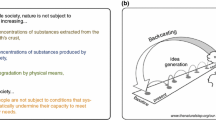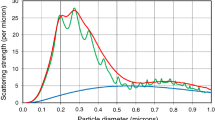Abstract
The history of the paint market shows that change quickly follows new technical advances or governmental regulation. Restrictions on the use of volatile organic compounds (VOCs) in architectural coatings are no exception. This paper examines the history of VOC regulations and resin technology in Europe compared to the U.S. Despite differences in formulations, substrates, and test methods, there are lessons that can be applied by U.S. paint makers and their suppliers. Other new directions in polymer synthesis and technology which may impact the paint industry are also discussed.
Similar content being viewed by others
References
Bullett, T.R., “Paint: A Changing Spectrum,”Rev. Prog. Coloration, Vol. 14, pp. 78–83 (1984).
World wide web, National Paint and Coatings Association website www.paint.org/ind_info/history.htm.
Brewer, G.E.F., “History of Painting: 75 Years,”Plating and Surface Finishing, June, pp. 57–60 (1984).
Pike, A., “Nineteenth and Twentieth Century Marker Materials in Architectural Paint,” English Heritage, London, pp. 56 (1994).
Boxall, J., “A History of Paint Technology, Part II: Mid-19th Century to 20th Century,”Paintindia, July, p. 6–12 (1982).
Stevens, V.L., “History of Styrene Copolymer Coatings in Organic coatings; Their Origin and Development,” inOrganic Coatings: Their Origin and Development, Seymour, R.B. and Mark, H.F. (Eds.), Elsevier Science Publishing Co., pp. 323–340 (1990).
Anonymous, “Coatings VI, A Multiple Client Study,” Skeist Inc., Whippany, NJ.
Mesbah, B. et al.,Paint and Coatings 2000: Review and Forecast, 2nd edition, National Paint and Coatings Association Management Information, Kline and Company, New York, 1998.
Anonymous, “Decopaint—Study on the Potential for Reducing Emissions of Volatile Organic Compounds (VOC) Due to the Use of Decorative Paints and Varnishes for Professional and Non-professional Use,” Final Report, EC DG Environment Tender E1/ETU/980084, pp. 316 (2000).
pra COMET, Vol. 2/98, p. 79ff (1998).
Kershaw, Y., “VOC Legislation on the Threshold of Change,”Eur. Coat J., No. 4, pp. 230–235 (1998).
Walker, J.H, “Coming Clean: How Pending Environmental Regulations Will Affect Paint and Coatings Formulators,”Mod. Paint Coat., April, pp. 16–41 (2000).
Anonymous, “Will This Be the Future of Paint?,”The Paint Dealer, May, p. 26–27 (2001).
Author information
Authors and Affiliations
Additional information
7201 Hamilton Blvd., Allentown PA.
Rights and permissions
About this article
Cite this article
Vratsanos, L.A. Meeting the challenge of formulating for the future. Journal of Coatings Technology 74, 61–65 (2002). https://doi.org/10.1007/BF02698370
Issue Date:
DOI: https://doi.org/10.1007/BF02698370




